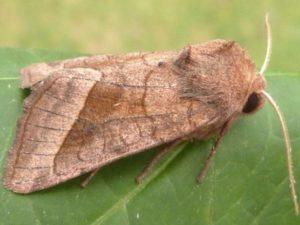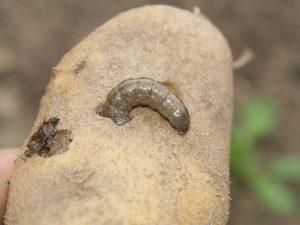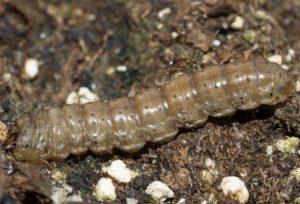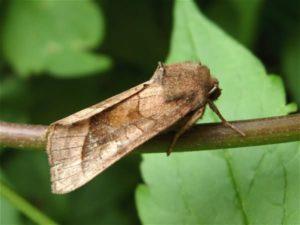Scoop - a pest of potatoes and other crops - how to prevent infection
One of the most common varieties of scoop is potato. The insect causes great damage to agriculture. The caterpillar damages not only potatoes, but also corn, tomatoes, raspberries, and strawberries. It feeds on more than 50 types of crops.
Content
Description of potato scoop
Name: Scoop potato, lilac spring, marsh
Latin: Hydraecia micaceaClass: Insects - Insecta
Squad: Lepidoptera - Lepidoptera
Family: Owls - Noctuidae
 | Habitats: | all over the world |
 | Dangerous for: | onion, garlic, various flowers, nightshade |
 | Means of destruction: | folk, chemical and biological preparations |
The wings have a span of 2,8 cm to 4 cm. The front wings can be grayish-yellow, brown-gray in color. There is also a reddish tint, transverse lines and spots. Rear - pinkish or grayish-yellow. A dark stripe is located at the top of the wing.
The caterpillar can be from light yellow to black with a reddish stripe along the back. Size from 40 mm to 50 mm. The pupa does not exceed 25 mm. The smallest is 17 mm. It has a yellow-brown color. The size of the egg is from 0,7 to 0,8 mm.
Life cycle
The whole cycle consists of 4 stages.
The female lays eggs from August to September. The clutch contains from 70 to 90 eggs.
The overwintered egg begins to develop in early May, sometimes at the end of April. The larvae appear reddish-brown. The size reaches 2 mm.
In May - June, they move from the leaves and settle on thick-stemmed plants and crops. The larva grows up and changes color to dark or pink. Grows up to 35 mm.
From late June to mid-July, the pupation period begins. At the end of July, adult larvae turn into brown caterpillars. Then they become butterflies.
Mid-September is characterized by crossing and egg-laying. This is the end of the yearly life cycle of scoops. The place of wintering of eggs is leaves.
One female lays up to five hundred eggs. In case of destruction of several eggs, additional spraying is necessary.
Habitat
Potato scoops are especially active from dusk to dawn. During the day, activity is almost 0.
| When to look for an owl | It is better to inspect the site in the evening. The insect hides in the bark of trees, floor boards, potato tubers. It's best to take a flashlight with you when walking around. |
| Accommodation features | The location of the site near an abandoned collective farm field increases the risk of an increase in the population. Over time, resistance to insecticides develops. |
| Weather dependence | The number of individuals is affected by weather conditions. Shade and moisture are very conducive to reproduction. After a rainy summer, a third of the leaves and stems may be damaged. |
| First signs | The first signs are visible in the area above the root collar. Dry weather contributes to the drying and wilting of problem plants, rainy weather contributes to rotting. |
Economic importance
The most dangerous are the larvae. They eat vegetables and berries. The larvae penetrate the stem and fruit, eating holes. They are also engaged in nibbling the ovaries of berries, flowers, rhizomes. Infected bushes wither, dry out, lose leaves.
Pathogenic microorganisms develop in a waterlogged garden. They get into the affected plants. The insect gnaws the stems at ground level, getting into the tubers and continuing to eat. The peel remains intact, and there is practically no pulp.
Owls eat:
- onions;
- garlic
- iris;
- lilies;
- strawberries;
- raspberries;
- corn;
- hops;
- tomato.
Methods of struggle
Caterpillars are the real danger. The use of pesticides in this case is not the best way out. Preference is given to biological preparations "Agrovertin" and "Fitoverma". In an extreme situation, the use of chemical compositions "Zeta", "Inta-Vir" is permissible. 1 tablet of the substance relies on 10 liters of water.
An excellent result is shown by "Bazudin" - a substance in granules, which is injected into the wells during planting. 20 kg of composition relies on 1 hectare. Very fast effect due to moist soil. Also worth noting is Nemabakt. Destroys caterpillars wintering in the ground.
Others 6 practical ways to deal with the armyworm look for the link.
Prevention
Prevention is very important.
- To prevent the appearance of potato scoops, weed plants are destroyed. You have to be especially careful with cereals. They are collected both on the site and beyond. This is due to the consumption of nectar by butterflies.
- Be sure to loosen the soil between the rows. Thus, hidden places are destroyed. It would be useful to periodically hill the growing bushes.
- Before frost, they thoroughly dig up the site, destroying winter shelters and preventing deep penetration.
- You can use lime. It is administered in dry calm weather. After that, they dig up the garden. 1 square meter of land is supposed to be from 0,45 to 0,85 g of lime.
- Instead of lime, you can use wood ash, egg shells. In this case, they are ground into powder.
- Be sure to inspect the beds and fruits. Caterpillars are collected by hand.
- With a small amount, spray with a decoction of wormwood.
https://youtu.be/2n7EyGHd0J4
Conclusion
Pest control is quite difficult. Under certain conditions, the number of individuals increases very quickly. For destruction choose any of the methods. However, taking preventive measures will eliminate this problem.
Previous


